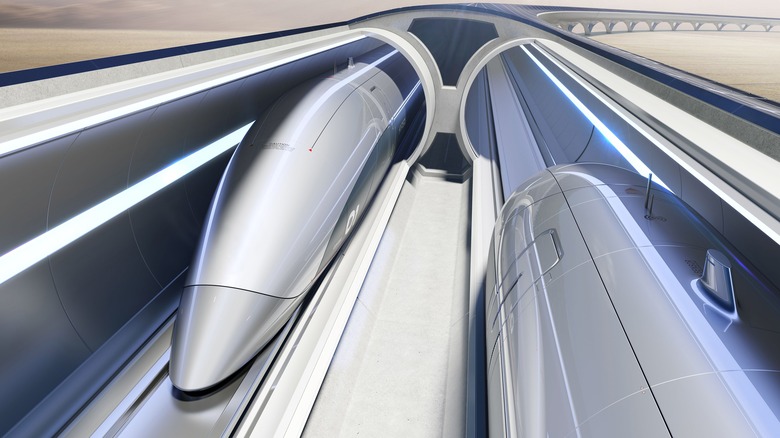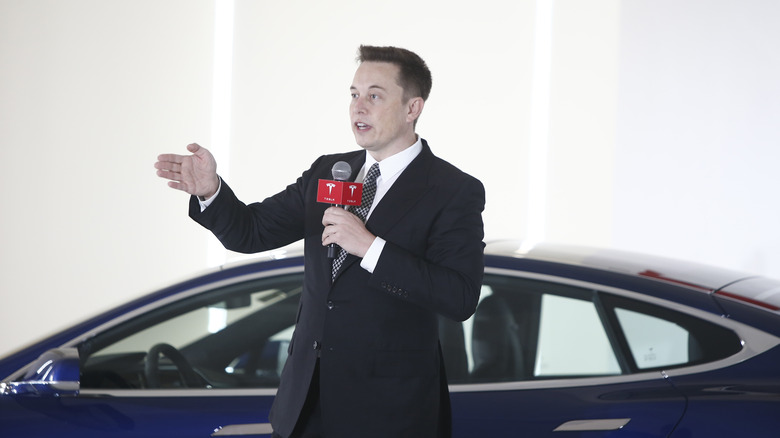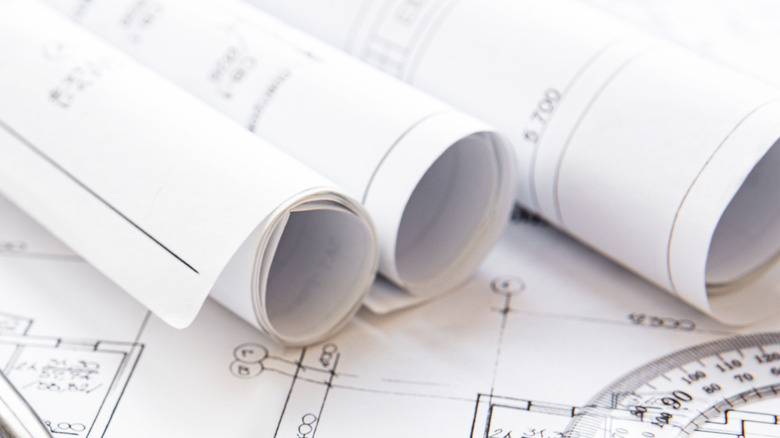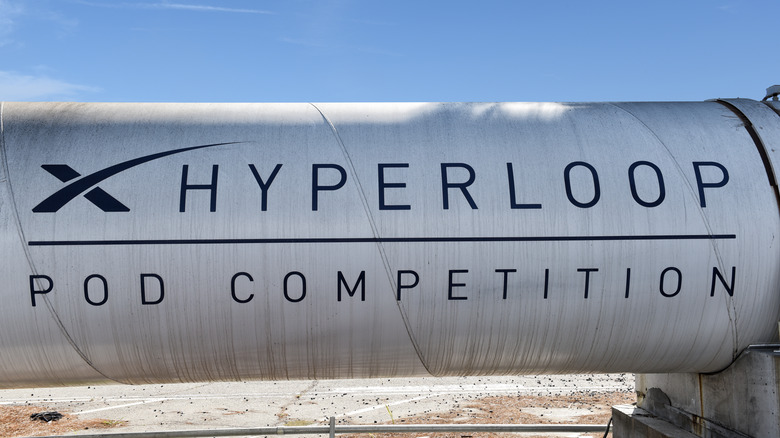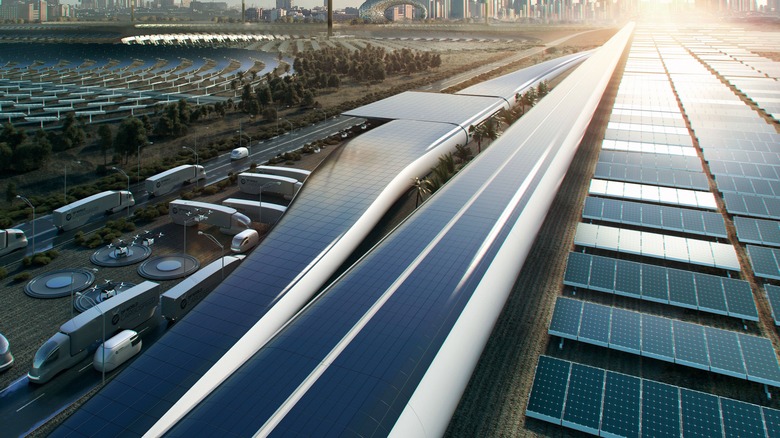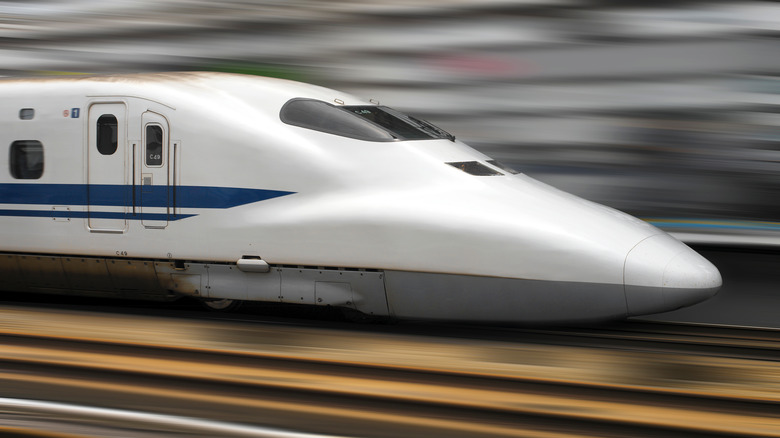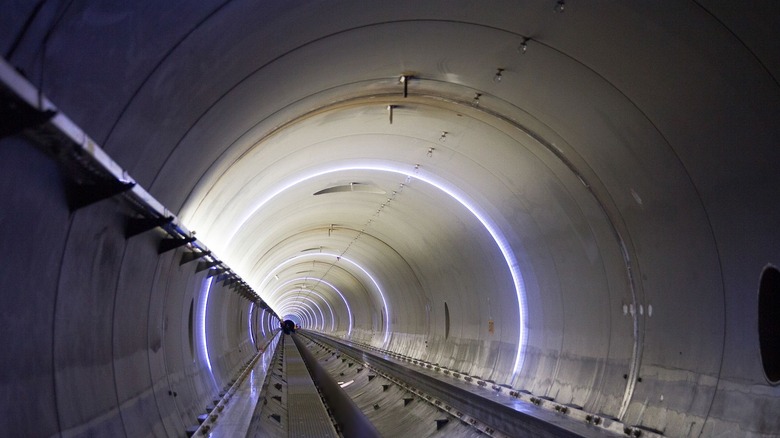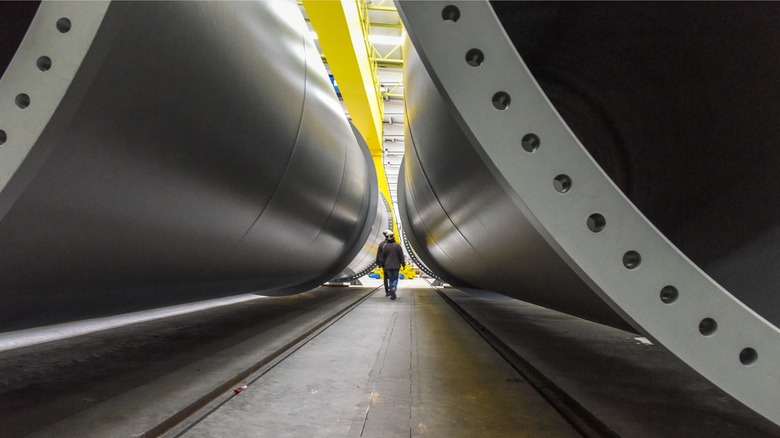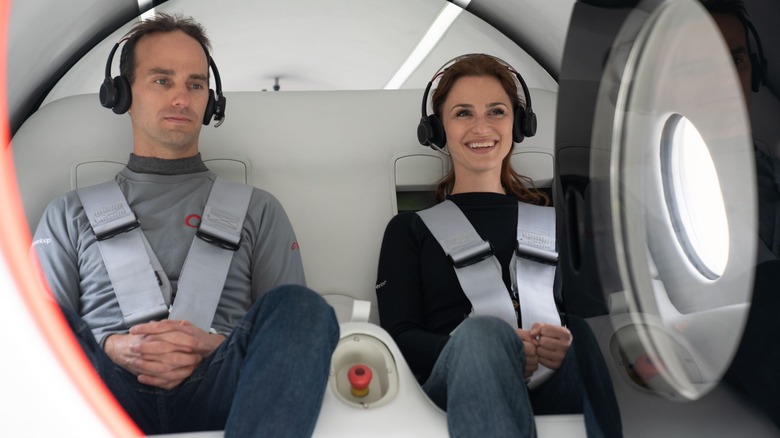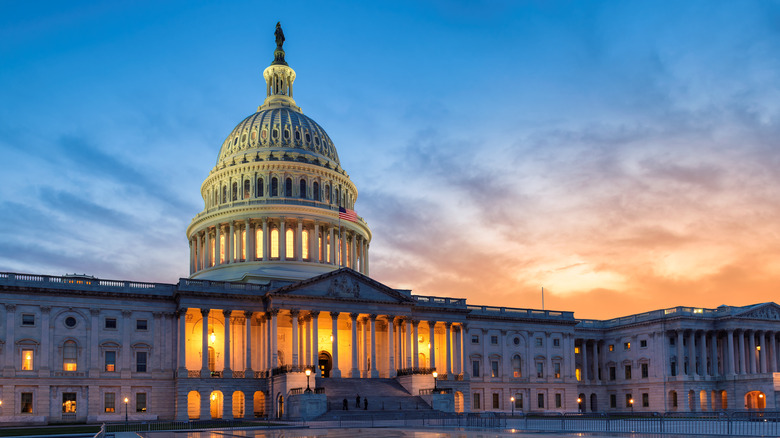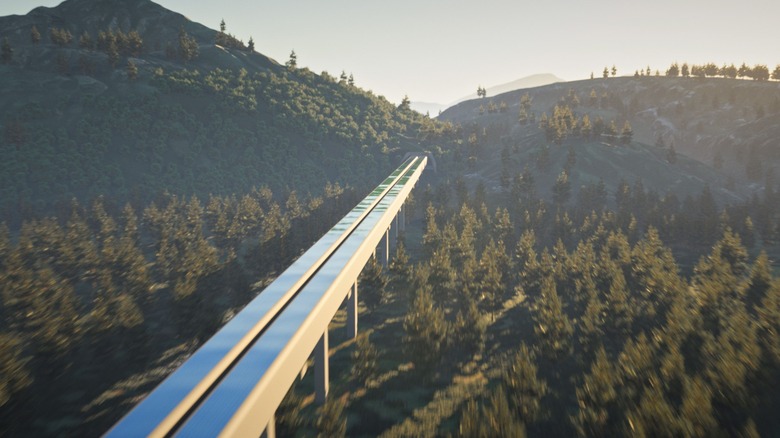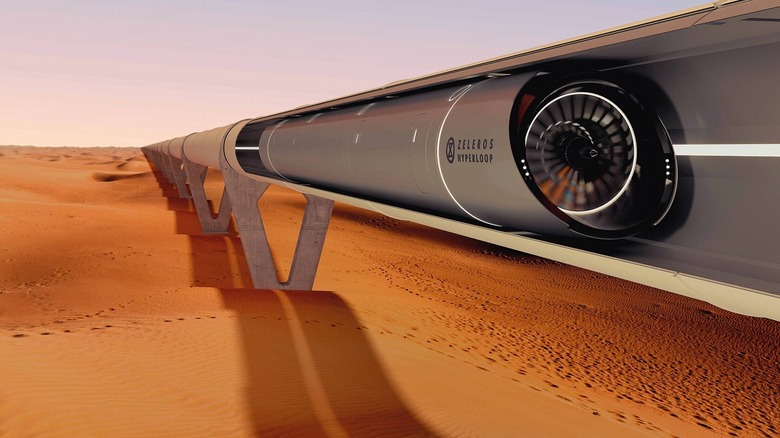Everything We Know About Elon Musk's Hyperloop Concept
Getting from place to place has always been a problem, and problems tend to inspire innovation. Cars, trains, planes, and even the humble boat exist because someone needed a better way of getting somewhere else. So what does the future hold?Just over the horizon is the hyperloop, which could be a revolution in land-based transport. The idea, and most of the science behind it, has been around for a long time — but it gained steam after Elon Musk started talking about his vision for a hyperloop.
Almost ten years later, we still don't have a hyperloop connecting two of the world's cities. But during that time, progress has been made — alongside a few more outlandish claims. So could you soon be traveling from LA to San Francisco in just over half an hour? Could you get from New York to Beijing in two hours? Can the power grid even support something like a hyperloop? Let's take an in-depth look at where the hyperloop is now.
Musk initially made some huge claims
Elon Musk getting overly optimistic about a big idea is nothing new — and he did the same with the hyperloop concept in 2012. Musk claimed a 350-mile-long hyperloop linking Los Angeles to San Francisco could be completed in a decade and would cost under $6 billion. It would do a better job than California's proposed high-speed rail network at a fraction of the cost.
Some of the claims Musk made were still seemingly outlandish but more rooted in reality. The Tesla CEO said the hypothetical LA to San Francisco loop would hit speeds of 750 MPH and transport 7.4 million people per year in each direction. HyperloopTT CEO Dirk Ahlborn has echoed these claims. Ahlborn believes hyperloop capsules can achieve near-sonic speeds, though they would initially be running at a slower pace than their maximum. Ahlborn also foresees a hyperloop capsule departing as often as once every 45 seconds.
Unfortunately, the speed predictions did not stop at a reasonable point. Musk went on to claim a hyperloop could transport someone from New York to LA in 45 minutes and from New York to Beijing in two hours. If it were even possible, the task would require a system thousands of miles long that spans both a continent and the world's largest body of water. Musk predicts the average cost of an LA to San Francisco Hyperloop journey will be $20. In 2021, $20 was equivalent to the price of a bus journey between the two cities, and a third of the cost of a plane or train (via Tripsavvy)
Tesla made their hyperloop research "open-source"
Although several of Elon Musk's companies are actively involved in hyperloop development, he didn't intend to build a hyperloop himself. In 2012, Musk proposed the idea alongside some suggestions about how it could work. The proposal included a paper released in 2013 by Tesla (PDF Download), which outlined the project and some of the science underpinning it.
Shortly before the paper was published, the Tesla CEO took to Twitter, where he expressed disdain for patents and said the hyperloop project would be open-source. From a practical standpoint, Tesla's hyperloop research and designs are freely accessible to anyone. Other companies can incorporate those designs in their work free of charge.
The open-source concept usually centers around software. The course code or core part of a piece of software is made publicly available so businesses and members of the public can build on it. Popular examples include Linux, Android, and Mozilla Firefox.
Several competing companies are working on the project
Multiple companies worldwide are working on hyperloop technology, the most notable of which are Virgin Hyperloop, Hardt, and Hyperloop TT. Although the basic principles underpinning a hyperloop remain the same, companies tackle the system's problems differently. For example, Virgin has abandoned one of the core ideas behind Tesla's original design. Instead of relying on a vast underground tunnel, their system will depend on an overground pipe.
SpaceX and The Boring Company also ran a "hyperloop pod competition" between 2016 and 2019. Enthusiasts, companies, and university teams brought their hyperloop capsules to Tesla's California-based testing track before being judged in several categories. Despite Musk outlining some big plans for the 2020 contest, including the addition of a longer route with curved sections, Tesla shelved the contest due to the COVID-19 pandemic. In 2021, it was replaced entirely by The Boring Company's tunneling competition. However, as with hyperloop development, Tesla's competition wasn't the only game in town. Hyperloop designers can test out their prototypes in the Netherlands during European Hyperloop Week.
It's a highly efficient transport solution
The hyperloop is capable of airline-like speeds while only using a fraction of the energy a plane needs. This isn't just another one of Elon Musk's ambitious claims. The US Department of Transport agrees that the hyperloop is three times more efficient over short-haul distances than air travel. NASA's research into the concept also confirms that travel by hyperloop is more efficient than a plane at distances of 250 to 500 miles. The US Department of Energy has reported that the current energy infrastructure could support a Hyperloop network, and the system would demand around 20% less energy than current modes of transport.
Hyperloop may also be far cleaner than other forms of transport. The pod itself is powered by electricity and produces zero emissions. However, that electricity has to come from somewhere and unless the hyperloop is powered by renewable energy, like solar, wind, or hydroelectric power, there will be a carbon footprint. Systems such as regenerative braking, which converts some of the energy a vehicle loses when slowing down into power, could see a hyperloop putting energy back into the electricity grid. Tesla's 2013 paper (PDF Download) on the Hyperloop mentioned that the system could easily be self-powering through a combination of solar panels mounted to the top of the hyperloop tube and batteries.
Parts of the technology were patented over a century ago
Hyperloop relies on the Maglev system, which the world's fastest trains have been using to get around for decades. Maglev uses powerful electromagnets to lift the train into the air and create a frictionless "track" to travel on. The electromagnets also propel the train forward and slow it down when necessary. The Department of Energy says the maximum speed of a Maglev train is 375 MPH. While trains have not reached this speed in practice, they have gotten incredibly close.
Japan's bullet train is probably the most famous use of the technology and has recorded speeds of 374 MPH — but the first Maglev train was far less impressive. The first commercial Maglev train appeared in Birmingham, England, during the 1980s. The Birmingham Maglev shuttled people between the city's airport and central train station at a far less impressive 26 MPH. The idea of combining magnets and train travel goes back to the early 1900s when several patents were filed based on the scientific principles Maglev now operates on. Rocketry pioneer Dr. Robert Goddard and French electrician Emile Bachelet are two of the more famous Maglev pioneers.
A low-pressure tube takes speeds to the next level
Despite the aerodynamic design, wind resistance is still a limiting factor in the speeds Maglev can achieve. Aerodynamic drag, or the force of the air pushing against an object traveling at speed, affects every vehicle on earth. Engineers design cars and fast trains to be "aerodynamic" to limit the amount of drag. Drag is more of a factor at sea level where the air is thicker, and planes traveling thousands of feet in the air where the atmosphere is thinner experience less drag.
Although a full vacuum would offer no air resistance and could see a Hyperloop reaching the fastest possible speeds, even Elon Musk is aware of the difficulty in creating and maintaining one. Regarding vacuums, Tesla's white paper states that: "The problem with this approach is that it is tough to maintain a near-vacuum in a room, let alone 700 miles (round trip) of tube with dozens of station gateways and thousands of pods entering and exiting every day." Instead, Tesla proposes a partial vacuum which would create an air pressure similar to an aircraft traveling at an altitude of 150,000 feet.
Other limits come with partial vacuums
Creating a partial vacuum in a tube leads to another problem that engineers must overcome. The Kantrowitz Limit, a gas dynamics principle discovered by Arthur Kantrowitz, could see the hyperloop hitting a literal wall of air. Musk describes the limit by likening a capsule traveling in a tube with a partial vacuum will act to the plunger in a syringe—compressing what little air there is until the air gets denser and slows the capsule. Over a short distance, there may not be enough air compression to make a difference, but the Kantrowitz Limit is a significant problem over the distances planned for the hyperloop.
The Tesla white paper describes the traditional ways around the Kantrowitz limit as going very slowly, going very quickly, and building a much larger tunnel than the capsule traveling down it. All of which are impractical. The most practical solution Tesla has come up with is an air compression system that will move air from in front of the capsule to behind it. A 2021 study published in the Journal of Wind Engineering and Industrial Aerodynamics suggested Tesla was correct and a compressor could make a difference.
Musk's tunneling company could play a huge part
Elon Musk launched a tunneling company in 2016, which could play a large part in the Hyperloop's implementation. The Boring Company is centered around digging transportation and freight tunnels to help relieve congestion in larger cities. It could also play a massive part in both hyperloop's construction and keeping costs down.
Musk claims his company will be able to dig tunnels for as little as $10 million to $15 million per mile—a fraction of what tunneling currently costs. The current price of tunneling depends on several factors, but tunnel-based projects can cost between $2.5 billion per mile in places like New York, to $100 million per mile in Asia (Via. Tunneling Online.)
Musk's company has yet to complete a project for under $15 million per mile. However, The Boring Company did complete a 1.7-mile-long tunnel-based project in Nevada for $47 million, which included three stations and was significantly cheaper than other tunnel projects — especially US-based ones.
Because of the speeds involved, any Hyperloop track will have to be as straight as possible. Even slight turns at high speed involve G-forces, and the Earth isn't flat. Tunneling straight through obstacles like hills and mountains makes more sense than going over or around them. If Musk's Boring Company can create those tunnels at a low price, the project's overall cost could drop by billions.
A hyperloop journey with passengers has already happened, and Musk wasn't the billionaire behind it
The first successful hyperloop journey with passengers happened in 2020, and neither Space X, Tesla, or The Boring Company was behind it. Virgin Hyperloop, which British billionaire Richard Branson partially backs, sent two passengers around its 500-meter test loop in Las Vegas. The loop is far smaller than the versions planned for the future. Virgin's eventual planned passenger capacity is around 28 people per pod — but successfully sending humans around a hyperloop is an important milestone.
However, the next passenger journey may not involve Virgin Hyperloop. In February 2022, The Financial Times reported that Virgin Hyperloop has scaled back its development of passenger travel and laid off 111 staff. The company's hyperloop research will now focus on freight. Virgin's refocus may not necessarily be a bad thing for hyperloop. Several other companies are developing the concept, and many still concentrate on passenger travel. A spokesperson for Virgin Hyperloop's majority shareholder DP World told the Financial Times that the company wants to create a system that delivers freight at "the speed of flight and closer to the cost of trucking." Such a system would have a massive impact on global logistics and the availability of goods.
Regulation will impact the Hyperloop
Although Hyperloop has similarities to existing transport systems — like Maglev trains — lawmakers may place Hyperloop in its own transport category. Logistics website Freightwaves says experts predict legislation will be passed before Hyperloop becomes a viable mode of transport. The website also speculates that regulations could slow down the development of Hyperloop and that different rules would apply to passenger and freight systems. One lawyer Freightwaves interviewed suggests that lawmakers will base passenger transport regulations on an old piece of legislation called "common carriage," which makes passenger safety a key duty of transport providers. Logistics company owner Chris Facey speculates the transportation of goods will be regulated under the National Motor Freight Classification system, which he calls "outdated."
The United States Congress included hyperloop provisions in its 2021 Infrastructure Bill. The bill made funding available to companies working on US-based hyperloop projects. Congress also codified the Non-Traditional and Emerging Transportation Technology (NETT) Council, a part of the Department of Transport responsible for regulating new transportation methods. CEO and Co-Founder of Virgin Hyperloop, Josh Giegel, welcomed the news saying: "Hyperloop's inclusion shows that we're on the precipice of a new era that will change the way we think about mobility in this country."
The first publicly accessible hyperloop could be in California
Tesla's Hyperloop white paper pitched Los Angeles to San Francisco as a route for the first hyperloop, describing it as "one of the most traveled corridors in the American west." Both cities have large populations, they also sit around 350 miles apart — which is an ideal distance for a hyperloop journey. Tesla initially predicted a hyperloop built on this route could send 7.4 million people in each direction each year, with each trip taking 35 minutes and costing $20.
Virgin Hyperloop also saw potential in a LA to San Francisco route. Although it has since shifted its focus to freight, Virgin claimed it could construct a hyperloop capable of getting passengers between the cities before 2030.
Other high-population Californian cities singled out as potential Hyperloop station locations in Tesla's white paper include San Diego, with a population of 3.1 million, and Sacramento, which is home to 2.6 million people.
It could also be built outside the US
Hyperloop development is not confined to the US, and several locations across the globe are racing to become one of the first hyperloop locations. Dubai, China, and Israel are all top contenders.
Dubai's government has invested heavily in hyperloop development and intends to have a functional hyperloop freight service by the mid-2020'ss. DP World, a copmany owned by the Dubai government, is the majority shareholder in Virgin Hyperloop. In 2017, Dubai became the site of Virgin Hyperloop's first international office. DP World also backed Virgin's recent shift in focus from passenger transport to shipping.
Like Elon Musk, China sees a hyperloop as a possible solution to traffic congestion. Chinese state-backed companies have invested a combined $1.3 billion into two US-based hyperloop development firms—Arrivo and Hyperloop Transportation Technologies. The investment seems to be paying off as Hyperloop TT now develops some of its technology on Chinese soil.
Israeli company Hyperloop IL is lobbying for a loop that will run between Tel-Aviv and the Red Sea. The company's pitch made the semi-finals of a 2017 Hyperloop One Global Challenge competition which aimed to find the perfect location for the company's first hyperloop. Since then, Hyperloop IL has worked towards an Israel-based hyperloop pilot scheme.
